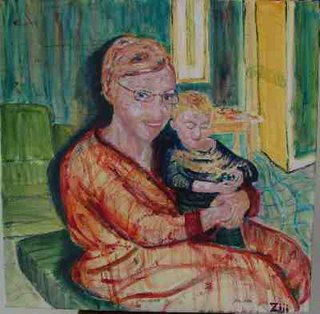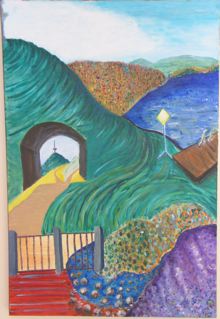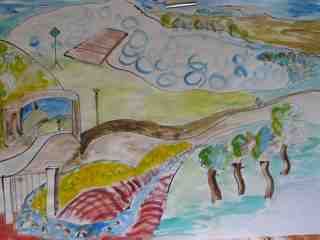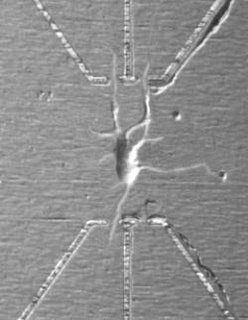A few readers have commented on their interest in watchng earlier paintings develop, so I thought I would blog this project somewhat in real time, and add the painting as it develops. I started with a photo (cropped her so you get an ieea of the colors). I know the person quite well so am in part working from memory of her vibrant personality and inner calm.

Preparatory stages;
I did a very quick ink and pen drawing outlining the shapes.
Then I did a more careful work up with pen, ink and color pencils. The distortions of neck and head matter little at this stage.

Then I traced an outline of the actual size of the canvas (18" x 24") onto paper and used charcoal to draw the persepctive lines and the figure and ceramic vases.
Then I went over that with brush and ink and finally roughly painted with gouache.
This is looking pretty good, so I felt confident enough to put it onto the canvas with a charcoal outline. About a days work so far.

Stage 1
The painting below is at the beginning of describing the landscape with acrylic paint. It's hot in Canberra at the moment and so I am adding a drying retarder to give me a bit of time. Usually acrylic in the summer will dry within minutes of application but with a little retarder I may have 20 and with a lot or retarder hours. It then moves around the canvas like oil paint.
The sky and clouds I am happy with and the perspective is great. I will continue in the next stage down into the swimming pool behind the figure and the large ceramic pots in the water.

Stage 2:
The next paintings begin building up the figure.
Already I have changed the roof color from warm ochre to cool grey and the area behind her face from a custard to a milky blue. I am intending to bring the figure forward by playing with warm reds and cool blues. If I had pre-planned it meticulously I may have anticipated that decision in stage 1. Or if I were to paint with a habit of playing off warm and cold like Mary Cassatt did in many of her domestic scenes, Imay have saved myself some time. But each step is a discovery for me and that is part of the excitement. If I plan too much I find that I tighten up and the figure then looks tight.
As you can see from the disproportion of her head, I am going to have to move the area of her eyes higher up toward the hair line in order to get the inflection of the head. In the full photo her head is lifted and angled back somewhat, giving an impression of a statement like, 'I'm here! Check out the pool behind me'.

Stage 3
This is six days into the work. I have lifted her eyes, reshaped the hair and forehead and begun to create a frame using the windows behind, which have curtains drawn. I have sharpenned the focus on her features and on the area around her. I painted her swimming gear hanging on the railling in the same colors as the blue vases and was surprised how effective it was. It seems to have brought life to the picture, creating a lovely triangular foundation, which connects the vases and the swim wear, bringing the figure forward of the picture plane. Emphasising the diagonals of the building, the swimming pool edge and now the imaginary triangle of vase and costume, and playing the warm and cold colors off each other, has projected the figure forward.
I will sit and look at it for quite some time before making a decision about the water. That will probably come as I start to bring out the features of her face and make small corrections in the background. It's tempting to follow the photograph and make the water a feature, which clearly in the architecture it is intended to be. A maxim of one of my teachers comes to mind: 'never become a slave to the photograph'.

Stage 4
It was a struggle to get here late in the afternoon and on a hot day. Yesterday's work I tightened up the background and removed glaring errors but I made such a mess of the figure that I was embarrassed to put a photo of that day's work on the web.
Today I have recovered the figure and solved the problem of the dress and the water.
Only last night did I get the idea that a red skirt would do it - this is a mixture of permanent alzaran crimson, ultramarine blue and dioxine purple with titanium white. The shirt is cadmium yellow deep, titanium white and a bit of alzaran crimson. I used a lot of retarder and after nearly an hour the paint was still wet - I hope I can keep my two year olds hands off it until tomorrow. he is free towander into the studio/garage where he has his own easel.
Finally today I have begun to deal with the weight of grey on the roof by putting a glaze of ochre, pthalo blue with titanium white. The next step will complete the face.



























